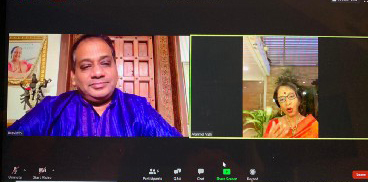What happens when two artistes — the legendary Bharatanatyam dancer-choreographer, Padma Bhushan Alarmel Valli and the multi-faceted Aravinth Kumaraswamy, Artistic Director, Apsaras Arts — come together to have a conversation? Well, what unfolds is, magic! This session for the Dance India Asia Pacific was hosted by Seema of Apsaras Arts.
Excerpts from an interview
Looking back, looking forward
“Honestly, in my past, I must have done a lot of good to have merited the great masters I’ve had; Titans, as I like to call them. The great, Pandanallur Chokkalingam Pillai and his son, Pandanallur Subbarayan Pillai. They were in a sense, repositories of the collective consciousness of a generation of gurus. They used to take classes in a Corporation school but despite the lack of aesthetics, they created for us a temple of art; there was a sense of divinity in these classes. They stood for high ideals of integrity and commitment.

The Pandanallur bani is an ancient bani and perhaps in the hands of a lesser guru, the bani can become straitjacket. But that was not the case with my gurus. They helped build for me a foundation in dance; a foundation of tradition but one that does not stagnate. They gave me the freedom to be my own dancer, to soar and to fly.”
An aside from my Arangetram
“I must tell you that I performed my Aranegtram when I was just nine-and-a-half; in hindsight, I’m surprised my gurus put me on stage rather early. Honestly, I was a child that didn’t enjoy the publicity. I remember sitting in my room; getting my make-up on and with huge flowers around my hair that was almost heavier than me. What I remember the most though after the Arangetram was the joy on the faces of my mothers and my Masters. And for me, the validation that came from my masters and my mother was the most special.”
More than mere lines
“We talk often about lines and geometry in dance but really, dance is about the subtexts, the inaffable moments — the twitch of an eyebrow, the flick of a hand, the turn of a head. The truth is that the more we get obsessed with mere physicality, the more likely is for the quality of our dance to go down. Finally, you see, dance is about spontaneity; the unpredictable moments that grow from the training of dance; of moments you yourself have not actually thought about, moments of beauty that are born in the course of the dance on the stage.
Dance should go beyond geometry.
Dance, for me, is Visual Poetry
“You see, poetry is not merely about taking a great poem and interpreting it in dance. The dance has to be poetic and musical. The measure of a complete artiste is the level of musicality in poetry that they bring to their dance.
“My engagement with poetry happened very young. My mother and my maternal grandfather — profound scholars in Tamil and English — would read poems to me. They sensitised me to the music inherent in poetry. The constant exposure to poetry and literature sensitised my ear to tone, to the music of language. To be honest, without literature and poetry you cannot become a good dancer.”
What makes a Solo Artiste
“A solo dancer has to be able to own that space she/he in. I don’t mean that in an arrogant way; what I mean it that it has to become your element in dance. If you do that, you can soar like a bird or dance with all the joy of the wild horses. You will find a sense of freedom and you can be the best you are capable of being.
But really, the freedom of being in your element comes with internalisation. As a soloist, you are naked, alone in front of the audience. There’s nothing to detract them.
Internalisation comes with more and more practice. The more you practice, the more the dance becomes spontaneous almost as the rhythms of breathing. And once you are free, you have the space to discover; dance then becomes an adventure. But internalisation is a process and calls for sadhana, a tapas.
The other imperative quality for a dancer is spontaneity. Practice is integral; sometimes leading up to a performance, I rehearse thrice a day but the rehearsal should not trap you. When you get up on stage, you go on to create dance that grows spontaneously, organically.”
My greatest achievement
“Perhaps it is the fact that I have, through all my life and its many ups and downs and even as I have negotiated this very trying, testing and sometimes not so pleasant world of dance, been true to the one quality that my mother taught me and that is to be true to myself and to my dance. I’d like to think that holding on to that and continuing to do so will remain my greatest achievement.”
Up next
The Evolution of the Margam by Dr Swarnamalya Ganesh tomorrow, September 6 at 7pm (SGT), 4.30pm (IST)









